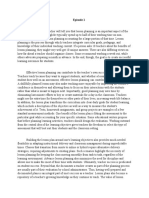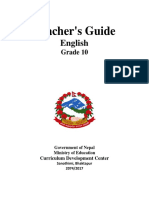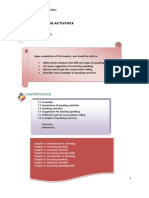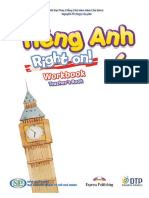Teaching Profession
Teaching Profession
Uploaded by
mka_10241990Copyright:
Available Formats
Teaching Profession
Teaching Profession
Uploaded by
mka_10241990Original Description:
Original Title
Copyright
Available Formats
Share this document
Did you find this document useful?
Is this content inappropriate?
Copyright:
Available Formats
Teaching Profession
Teaching Profession
Uploaded by
mka_10241990Copyright:
Available Formats
Langngag, Monika E. 5-8PM Friday The Teaching Profession Final Exam 1.
What are some characteristics of successful classroom manager? How many of these characteristics coincide with your management bahaviors? Here are some characteristics of successful classroom manager and how each characteristic coincide with management behaviours. Preparation and Time Management Preparation means not only having a lesson plan in place, but also preparing the classroom for the lesson. Supplies, equipment or handouts should be close at hand so no "down time" intrudes while the teacher looks for materials. Additionally, checking technology before the lesson, to be sure that everything is properly connected and in good working order, lessens the chance that plans will be interrupted and students distracted. Outlines and Posts Expectations Clearly outlining academic and behavioral expectations at the beginning of the first class makes a smooth ride in the classroom possible. If the teacher covers academic and behavioral expectations verbally and provides an opportunity for questions, students start out knowing what's expected and exactly what to do to succeed. Posting these expectations will serve as a daily reminder of what actions are required for success. Outlines and Posts Consequences Covering academic and behavioural expectations is effective only if the students know what consequences will follow failure to meet the standard. The effective classroom manager verbally covers the consequences of non-compliance and posts these consequences in the classroom. Posting daily reminders will help to guide students' actions while they are learning responsibility. These consequences may cover misbehaviour in the classroom as well as evidence of a lack of work ethic. Consistency An effective classroom manager is consistent. Students perform best in an educational environment in which they know the routine. Establishing consistent routines facilitates classroom management and student achievement. It results in less down time and fewer discipline problems. Additionally, students accept behavioural and academic consequences better when they see that the consequences are applied consistently. 2. Which Filipino values pose obstacles to your value formation? How do they block your value formation? Among the Filipino valuesutang-na loob can pose obstacles to value formation because the trait is mostly used to obtain power, wealth or to avoid imprisonment. A
family member may be appointed or promoted due to utang-na-loob, not personal qualifications. 3. What are the best methods for incorporating instructional materials into lessons? Knowing how to find the best instructional materials is a valuable skill for a teacher to have because each student learns differently. Some students are kinesthetic learners, requiring a hands-on approach to learning. Some students learn visually, excelling when they can read or see photographs of the material. Other students learn best through listening, learning best when they can hear and talk through a problem. Furthermore, all students are talented in different ways. While one student may be creative, another student may be analytical. While one student may be mechanical, another student may excel at writing. Teaching requires differentiated and individualized instruction in order to reach all students. 4. How can the interaction between the teacher and students in the classroom be measured? Give some examples. The interaction between the teacher and students in the classroom can be measures through written work of the pupils/students, e.g. themes, assignments and homeroom. Also, recitation, questioning and discussions provide evidence of learners progress. In addition, test may be given to measure and evaluate the results of instruction. 5. What changes would you make in schools if you were asked to make them? Why? The curriculum because in order to give the quality education to pupils/students, it must undergo considerable planning since it is used to assist students/pupils in attaining selected and desired learning outcome to the best of their abilities. Hence, curriculum must be plan in a way that is abreast of information and of the prevailing culture. 6. Of the qualities of a professional which is most important? Why? Of the qualities of a professional, mastery of the subject matter is the most important because it is the first essential requisite of effective teaching. The teacher must have a thorough grasp of the subject he teaches. He must possess a wide range of knowledge and information of the subject. 7. Why is it very important to consider teacher as a professional and teaching as a profession? It is very important to consider teacher as professionals and teaching as a profession because it held great responsibility in the teaching-learning process. It would help maintain a high standard of personal and professional conduct. 8. How will the teacher exchange programs develop you as a global teacher? The teacher exchange programs develop one to be a global teacher by giving teachers the opportunity to live their personal and professional lives in another context,
in another setting, in another country, thus strengthening their skills in understanding diversity and multiculturalism. Also, by providing an opportunity for teachers to teach in other countries will extend their experiences and widen their horizon. Thus, it will broaden their understanding of one anothers cultures, customs and languages. 9. Explain values are caught not taught? I would like to explain what it means by values are caught and not taught based on Kohlberg theory. It is indeed that values are caught because children begin to perceive themselves as responsible to others because of the importance of getting along and of being a good citizen. They seek to act appropriately because people matter to them, not just to avoid punishment. Childrens developing psychological understanding heightens their sensitivity to human needs and contributes to empathy for others 10. What are the salient features of the k to 12 programs of the Philippines? In K to12 education system, all the students are given individual attention and hence they understand their subjects in a more practical way. The role of a teacher here is just to guide them in the right way and provide them with learning opportunities. What really happens is that, the individual discovers his own learning capacity and success depends on the thinking ability of the student. The students are encouraged to bring about their personal thoughts and visions. Students enrol themselves in different forums and educational clubs where they get to discuss many points for the same topic and get different views. The teachers here contribute so much as to turning every discussion into a positive note cooperating with the students. Furthermore, the K to 12 will provide every Filipino child access to early childhood education through Universal Kindergarten. At 5 years old, children start schooling and are given the means to slowly adjust to formal education. Research shows that children who underwent Kindergarten have better completion rates than those who did not. Children who complete a standards-based Kindergarten program are better prepared, for primary education. In Kindergarten, students learn the alphabet, numbers, shapes, and colors through games, songs, and dances, in their Mother Tongue. Aside from the Mother Tongue, English and Filipino are taught as subjects starting Grade 1, with a focus on oral fluency. In Grade 4, English and Filipino are used as the primary Medium of Instruction (MOI). After Grade 1, every student can read in his or her Mother Tongue. Learning in Mother Tongue also serves as the foundation for students to learn Filipino and English easily. Senior High School is two years of specialized upper secondary education; students may choose a career track based on aptitude, interests, and school capacity. The choice of career track will define the content of the subjects a student will take in Grades 11 and 12. These subjects fall under either the Core Curriculum or specific Career Pathways.
You might also like
- Gold C1 Advanced NE UT02Document2 pagesGold C1 Advanced NE UT02Livia SantinhoNo ratings yet
- Unlimited Memory Audiobook CompanionDocument13 pagesUnlimited Memory Audiobook CompanionT-Fi DrNo ratings yet
- Summary of Carol Ann Tomlinson's How to Differentiate Instruction in Academically Diverse Classrooms, Third EditionFrom EverandSummary of Carol Ann Tomlinson's How to Differentiate Instruction in Academically Diverse Classrooms, Third EditionNo ratings yet
- Visually Impaired PresentationDocument11 pagesVisually Impaired PresentationRajesh SoniNo ratings yet
- Dec 1 1Document39 pagesDec 1 1Ekoy TheRealNo ratings yet
- Summary OutputDocument5 pagesSummary Outputlapocmarivic6No ratings yet
- The Different Phillipine Professional Standard For TeacherDocument5 pagesThe Different Phillipine Professional Standard For TeacherGeraldine Taag MilanaNo ratings yet
- MPU 3222 Acedemic Writing (Chua)Document9 pagesMPU 3222 Acedemic Writing (Chua)jeckNo ratings yet
- Language Orientation Virtual EnvironmentDocument16 pagesLanguage Orientation Virtual EnvironmentZulhitjarin NasutionNo ratings yet
- Tutorial Assignment: Communicative Learning Teaching (CLT)Document7 pagesTutorial Assignment: Communicative Learning Teaching (CLT)Sybil CuizNo ratings yet
- 1.know Your Learners: Some Practices For Principle 1Document8 pages1.know Your Learners: Some Practices For Principle 1alexNo ratings yet
- HN19022022 - Phungbaoanh (Elementary)Document37 pagesHN19022022 - Phungbaoanh (Elementary)Bảo Anh PhùngNo ratings yet
- All Students Can LearnDocument9 pagesAll Students Can Learnapi-438367969No ratings yet
- Profed7 Cm1 Engaged: Classroom Visitor 7. Field Trip and Service Learning 8. Context Curriculum 9. Impact InvestigationDocument9 pagesProfed7 Cm1 Engaged: Classroom Visitor 7. Field Trip and Service Learning 8. Context Curriculum 9. Impact InvestigationAndrea Mae DelimaNo ratings yet
- No Graded CurriculumDocument34 pagesNo Graded CurriculumPax GarciaNo ratings yet
- Meaning of EducationDocument4 pagesMeaning of EducationBach MansyurNo ratings yet
- Module 13 - Week 13: Cit Colleges of Paniqui FoundationDocument6 pagesModule 13 - Week 13: Cit Colleges of Paniqui FoundationKeith CatbaganNo ratings yet
- Teacher Expectation & Student PerformanceDocument31 pagesTeacher Expectation & Student PerformanceNhil Cabillon QuietaNo ratings yet
- El1 Task3Document2 pagesEl1 Task3Irenea Raut AmpasinNo ratings yet
- Module 6 ReflectionDocument3 pagesModule 6 Reflectionapi-555798556No ratings yet
- TeacherDocument14 pagesTeacherLhara Campollo100% (1)
- Final PortfolioDocument38 pagesFinal PortfolioKristine Mae UstaresNo ratings yet
- (Template) Prof Ed 7 - Ch1Lesson 2Document6 pages(Template) Prof Ed 7 - Ch1Lesson 2jennymacion20No ratings yet
- Mother Tongue-Based Multilingual Education (MTB-MLE)Document4 pagesMother Tongue-Based Multilingual Education (MTB-MLE)Amor DianneNo ratings yet
- Acei PortfolioDocument18 pagesAcei Portfolioapi-264661011No ratings yet
- Episodes 1-3Document4 pagesEpisodes 1-3Franz Simeon ChengNo ratings yet
- Surell John Lery ED 33 Assignment 1 Foundation For Special Inclusive EducationDocument6 pagesSurell John Lery ED 33 Assignment 1 Foundation For Special Inclusive EducationJohn Lery SurellNo ratings yet
- Prelim Exam Zyrish LunaDocument3 pagesPrelim Exam Zyrish LunaMary Joy T. PuyoNo ratings yet
- Summary 1-4Document13 pagesSummary 1-4api-305009900No ratings yet
- PPST Domains ReflectionDocument5 pagesPPST Domains ReflectionJARYL PILLAZARNo ratings yet
- CPE108 A6 (Curricula 1)Document8 pagesCPE108 A6 (Curricula 1)CORINNE FAITH BASLOTNo ratings yet
- 195d140231034 ELT303Document7 pages195d140231034 ELT303Thu HIềnNo ratings yet
- 6 Qualities of Successful ESL TeachersDocument3 pages6 Qualities of Successful ESL TeachersJoyce Jane JennyNo ratings yet
- Assignment No 1 (8601)Document35 pagesAssignment No 1 (8601)Butt ArbabNo ratings yet
- Portfolio Final ReflectionDocument8 pagesPortfolio Final Reflectionapi-646268236No ratings yet
- Teaching TeenagersDocument17 pagesTeaching TeenagersJoselo VasquezNo ratings yet
- Felix O Alfelor Sr. Foundation College Sipocot, Camarines Sur Prod Ed 6. Principles of Teaching 2 3rd Summative Test Essay: Explain Your AnswerDocument2 pagesFelix O Alfelor Sr. Foundation College Sipocot, Camarines Sur Prod Ed 6. Principles of Teaching 2 3rd Summative Test Essay: Explain Your AnswerMerlinda CarilloNo ratings yet
- A Statement Outlining Educational Beliefs and Teaching StyleDocument4 pagesA Statement Outlining Educational Beliefs and Teaching StylebetulseyhanNo ratings yet
- Online Seminar SummaryDocument8 pagesOnline Seminar SummaryHryne C BanzuelaNo ratings yet
- Foundation of EducationDocument5 pagesFoundation of EducationMelbert GuiangNo ratings yet
- Lilibeth 7 DoimnDocument10 pagesLilibeth 7 DoimnJoylene CagasanNo ratings yet
- My Teaching PhilosophyDocument3 pagesMy Teaching Philosophy曹永坤No ratings yet
- GRP. 7 Inclusive Education For Educational Needs (Philippines & U.S.A)Document13 pagesGRP. 7 Inclusive Education For Educational Needs (Philippines & U.S.A)Chambee ChambeeNo ratings yet
- Al Ahl Barretto 7,8,9,10Document5 pagesAl Ahl Barretto 7,8,9,10Cir Arnold Santos IIINo ratings yet
- (RESEARCH ARTICLE) - Project PHIL-IRI (Program For Higher, Intensive, and Laddered Instruction Towards Reading Improvement) - MARIBEL P. ABAYADocument16 pages(RESEARCH ARTICLE) - Project PHIL-IRI (Program For Higher, Intensive, and Laddered Instruction Towards Reading Improvement) - MARIBEL P. ABAYAMaribel AbayaNo ratings yet
- Single-Dual SportDocument22 pagesSingle-Dual SportAngel Marie CahanapNo ratings yet
- Intersol Unit 3 Module 1Document6 pagesIntersol Unit 3 Module 1shagun sudNo ratings yet
- RS1016 - Grade 10 English TG Final PDFDocument371 pagesRS1016 - Grade 10 English TG Final PDFAlbert EinsteinNo ratings yet
- Mooc ReflectionDocument2 pagesMooc ReflectionElaine Joy O. ApostolNo ratings yet
- Characteristics of Good Learning Outcomes 2Document15 pagesCharacteristics of Good Learning Outcomes 2christine.oliva62No ratings yet
- Advanced Principles and Methods of TeachingDocument4 pagesAdvanced Principles and Methods of TeachingJerric AbreraNo ratings yet
- Philippine Professional Standards For TeachersDocument3 pagesPhilippine Professional Standards For TeachersGelii BeduyaNo ratings yet
- Session 3: Session 4 Teaching As A Profession and As AvocationDocument6 pagesSession 3: Session 4 Teaching As A Profession and As AvocationJaz ZeleNo ratings yet
- Narrative ReportDocument11 pagesNarrative ReportJoseph AgoyaoyNo ratings yet
- Teachers Public Speaking Ability in Teaching English at Islamic Boarding School in Karawang RegencyDocument7 pagesTeachers Public Speaking Ability in Teaching English at Islamic Boarding School in Karawang RegencyThùy LinhNo ratings yet
- PA00N39ZDocument108 pagesPA00N39ZfikruNo ratings yet
- EducationalphilosphyDocument2 pagesEducationalphilosphyapi-311735472No ratings yet
- EFN 3201 Handout 8 The Role of TeachersDocument5 pagesEFN 3201 Handout 8 The Role of TeachersMarsha SinghNo ratings yet
- Research Is New Strategies For The 21 Century Teachers?Document7 pagesResearch Is New Strategies For The 21 Century Teachers?Alain Dave Tabbu WañaNo ratings yet
- 6 Best Teaching Strategies For 2023Document32 pages6 Best Teaching Strategies For 2023JC Viacrucis JuaneroNo ratings yet
- ProcessquestionsDocument3 pagesProcessquestionsBridgette Wynn ArienzaNo ratings yet
- Personalising Learning in the Primary Classroom: A Practical Guide for Teachers and School LeadersFrom EverandPersonalising Learning in the Primary Classroom: A Practical Guide for Teachers and School LeadersNo ratings yet
- BARANGAYDocument1 pageBARANGAYmka_10241990No ratings yet
- Pre Trial DefenseDocument2 pagesPre Trial Defensemka_10241990No ratings yet
- BARANGAYDocument1 pageBARANGAYmka_10241990No ratings yet
- 10 Cases ObliconDocument10 pages10 Cases Obliconmka_10241990No ratings yet
- Connie Mason - Surrender To FuryDocument124 pagesConnie Mason - Surrender To FuryPortia Rossi80% (5)
- Connie Mason - Surrender To FuryDocument124 pagesConnie Mason - Surrender To FuryPortia Rossi80% (5)
- 20 CasesDocument17 pages20 Casesmka_10241990No ratings yet
- How To Learn Any Language in Six MonthsDocument6 pagesHow To Learn Any Language in Six MonthsThai ChheanghourtNo ratings yet
- Activity 03Document11 pagesActivity 03kennethNo ratings yet
- UWS MBA HR Leadership TheoriesDocument32 pagesUWS MBA HR Leadership TheoriesNirushini ThurairajNo ratings yet
- Supply Chain Management: An International Journal: Article InformationDocument17 pagesSupply Chain Management: An International Journal: Article InformationJames HudionoNo ratings yet
- Topics in EnglishDocument25 pagesTopics in EnglishAdrienne Nicole Dy100% (1)
- Types of ContextDocument6 pagesTypes of ContextKateaPoleacovschiNo ratings yet
- Premise Conclusion and Conditional IndicatorsDocument6 pagesPremise Conclusion and Conditional IndicatorsAbu samuraNo ratings yet
- Introduction To LinguisticsDocument5 pagesIntroduction To LinguisticsIna BaraclanNo ratings yet
- 2022 McKinsey Taipei Scholar ProgramDocument5 pages2022 McKinsey Taipei Scholar Program巫信霈No ratings yet
- Annual Plan 8th EGBDocument3 pagesAnnual Plan 8th EGBmaira mora100% (1)
- Journal Educational Psychology Learninng StyleDocument43 pagesJournal Educational Psychology Learninng StyleAida Fitriyane HamdaniNo ratings yet
- C262128 PDFDocument8 pagesC262128 PDFaijbmNo ratings yet
- English Banana The Second BookDocument88 pagesEnglish Banana The Second BookReni Putri GeminiNo ratings yet
- What Is Data StructureDocument5 pagesWhat Is Data StructureSwapnil ChaudhariNo ratings yet
- Chapter SEVEN - ACTIVITIES.Speaking PDFDocument19 pagesChapter SEVEN - ACTIVITIES.Speaking PDFEsther Ponmalar Charles100% (1)
- First Course: What Is Literature?: Literature Courses of Sidi Bel Abbes LMD First YearDocument4 pagesFirst Course: What Is Literature?: Literature Courses of Sidi Bel Abbes LMD First YearbelbachirNo ratings yet
- CHAPTER 13 (How To Write Chapter 1 The Prob and Its Setting)Document9 pagesCHAPTER 13 (How To Write Chapter 1 The Prob and Its Setting)Kimberly Dazo100% (1)
- A Course in In-Memory Data Management: Prof. Hasso PlattnerDocument6 pagesA Course in In-Memory Data Management: Prof. Hasso PlattnerAlexandru MoldovanNo ratings yet
- Quantifying Compensatory Strategies in Adults With and Without Diagnosed AutismDocument10 pagesQuantifying Compensatory Strategies in Adults With and Without Diagnosed AutismJULIANo ratings yet
- Sách giáo viên điện tử (bài tập) - Tiếng anh 6 Right On!Document96 pagesSách giáo viên điện tử (bài tập) - Tiếng anh 6 Right On!ThanhTungNguyenNo ratings yet
- Module FinalDocument11 pagesModule Finalkathleen gonzaNo ratings yet
- Glossary and Terms MYP DesignDocument3 pagesGlossary and Terms MYP DesignVictoria VaronaNo ratings yet
- Module 4 5 6 Entrepreneurial MindDocument60 pagesModule 4 5 6 Entrepreneurial MindBettymae AndayaNo ratings yet
- Social Studies Unit 1 Mapping and GeographyDocument10 pagesSocial Studies Unit 1 Mapping and Geographyapi-490371867No ratings yet
- Human Resource Management SyllabusDocument1 pageHuman Resource Management SyllabusPiotrProkopowiczNo ratings yet
- Farsi Phrases PDFDocument23 pagesFarsi Phrases PDFabimranf3975% (4)
- TishaDocument1 pageTishaTisha VERMANo ratings yet
- Multi Tiered Phonology by Hiba NassrullahDocument33 pagesMulti Tiered Phonology by Hiba Nassrullahza100% (1)






























































































